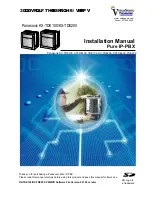
Medical
—consult the manufacturer of any personal medical devices, such as pacemakers, to determine if they
are adequately shielded from external RF (radio frequency) energy. (The unit operates in the frequency range
of 1881 MHz to 1898 MHz, and the output peak power level is less than 0.25 W.) Do not use the unit in health
care facilities if any regulations posted in the area instruct you not to do so. Hospitals or health care facilities
may be using equipment that could be sensitive to external RF (radio frequency) energy.
DECT 6.0 Cell Station
Medical
—consult the manufacturer of any personal medical devices, such as pacemakers, to determine if they
are adequately shielded from external RF (radio frequency) energy. (The unit operates in the frequency range
of 1920 MHz to 1930 MHz, and the output peak power level is less than 0.12 W.) Do not use the unit in health
care facilities if any regulations posted in the area instruct you not to do so. Hospitals or health care facilities
may be using equipment that could be sensitive to external RF (radio frequency) energy.
SECURITY REQUIREMENTS
In order to use the PBX safely and correctly, the Security Requirements below must be observed. Failure to
do so may result in:
•
Loss, leakage, falsification or theft of user information.
•
Illegal use of the PBX by a third party.
•
Interference or suspension of service caused by a third party.
What is User Information?
User Information is defined as:
1.
Information stored on the SD Memory Card
Phonebook data, user IDs, system settings data, passwords (User/Administrator/Installer), Personal
Identification Numbers (PINs), etc.
2.
Information sent from the PBX to a PC or other external device:
Phone call data (including telephone numbers of outside parties), call charge data, etc.
Requirements
1.
The SD Memory Card contains software for all the processes of the PBX and all customer data. It can be
easily removed and taken away from the PBX by a third party. Therefore, do not allow unauthorised access
to prevent data leakage.
2.
Always make backups of data stored on the SD Memory Card. For details, refer to "2.6.2 Utility—File
Transfer PC to PBX (SD Card)" and "2.6.3 Utility—File Transfer PBX (SD Card) to PC" in the PC
Programming Manual.
3.
To prevent illegal access from the Internet, activate a Firewall.
4.
To avoid unauthorised access and possible abuse of the PBX, we strongly recommend:
a.
Keeping the password secret.
b.
Selecting a complex, random password that cannot be easily guessed.
c.
Changing your password regularly.
5.
Perform the following when sending the PBX for repair or handing it over to a third party.
a.
Make a backup of data stored on the SD Memory Card.
b.
Using an SD formatter, format the SD Memory Card so that information cannot be retrieved from it.
6.
To prevent data leakage, render the SD Memory Card physically unusable before disposal.
7.
When user information is sent from the PBX to a PC or other external device, the confidentiality of that
information becomes the responsibility of the customer. Before disposing of the PC or other external device,
ensure that data cannot be retrieved from it by formatting the hard disk and/or rendering it physically
unusable.
Notice
10
Installation Manual
Important Information
Summary of Contents for KX-TDE100
Page 40: ...40 Installation Manual 1 4 3 System Capacity ...
Page 48: ...48 Installation Manual 2 1 3 Activation Key File ...
Page 262: ...262 Installation Manual 3 16 1 Starting the PBX ...
Page 270: ...270 Installation Manual 4 3 1 Installing and Starting the Maintenance Console ...
Page 283: ...Section 6 Appendix Installation Manual 283 ...
Page 286: ...286 Installation Manual 6 1 2 PMMPR Software File Version 2 01xx ...
Page 287: ...Index Installation Manual 287 ...
Page 293: ...Installation Manual 293 Notes ...

























